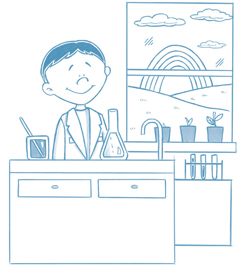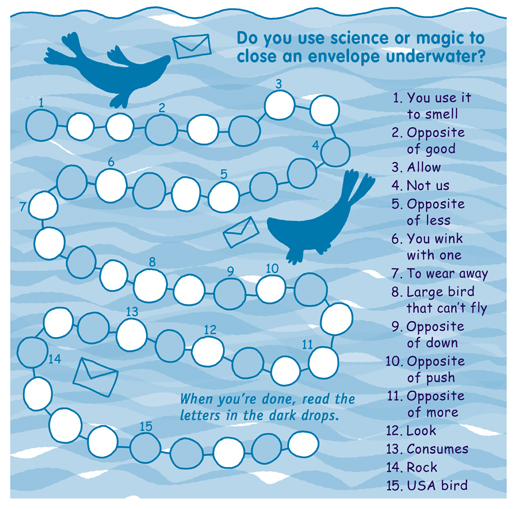Everything Kids' Magical Science Experiments Book (9 page)
Read Everything Kids' Magical Science Experiments Book Online
Authors: Tim Robinson
Tags: #epub, ebook

The Greek scientist Archimedes once famously shouted “EurekaâI've found it!” when he discovered the concept of buoyancy and ran through the streets of town announcing his discovery. Unfortunately, this realization came to him while he was bathing in his bathtubâ¦wearing no clothes. What Archimedes figured out is that objects have to move water out of the way in order to be placed in it. That water has weight. He found that the weight of that displaced water is the same as the force that lifts up the object in the water. If that force is enough, the object can float. A block of wood is an example of something that experiences a buoyant force equal to its weight. A bowling ball, however, doesn't experience a large enough buoyant force, and so it sinks.
- Several pieces of fruit
- Large bowl of water
- Adult helper
- Knife, for peeling the fruit
- Select a fruit and predict whether or not it will float when placed in the water.
- Place the fruit in the water and observe whether or not it floats.
- Ask your adult helper to assist you as you peel the fruit.
- Once you have completely removed the peel, place the fruit in the water again and observe whether or not it floats.
- Select another fruit and repeat steps 2â4. Do this for each fruit that you have selected for the experiment.
- Which fruits floated when they still had their peels?

- For the fruits that floated with their peels, what about their peels made them float?

- Which fruits floated even without their peels?

- Was there something those floating fruits had in common that made them float, even without their peels?

- Using what you observed in this experiment, describe an outfit you could wear that would help keep you afloat in a swimming pool.


Oranges tend to produce very specific results in experiments such as this one. That is because of the way their peels are made. On the surface of orange peels are hundreds of tiny pits that collect air. Collectively, these air pockets act like a sort of life preserver for the orange, and keep it afloat. When the peel is removed, the inside of the orange is heavier than the water, and it sinks to the bottom of the bowl. Other fruits that do not have these pits in their peels tend not to float as well as the oranges do. As a follow-up experiment, try other liquids such as salt water (which tends to be more dense than fresh water) or fruit juice to see if the same fruits produce the same results in these other liquids.
Hurricanes form where winds and warm water meet. See how they work, learn about the devastation they can bring, and explore some fun hurricane activities at
http://42explore.com/ hurricane.htm.
Question: Does Colored Water Rise?
- 2 identical small-mouthed bottles
- Food coloring
- Cold water
- Hot water
- 3â³ Ã 5â³ note card
- Fill one bottle with cold water.
- Fill the other bottle with hot water from the tap.
- Add food coloring to the hot water until its color is dark.
- Place the note card over the top of the bottle containing the cold water.
- Invert the bottle of cold water and place its mouth directly on top of the bottle containing the colored hot water.
- Carefully remove the note card from between the two bottles.
When you remove the note card, you should begin to see wisps of colored water rising into the upper bottle. It's not a magic water genie. Instead, it's the hot water trading places with the cold water. You see, hot water is less dense than cold water. So when the two are placed together, the cold water falls to the bottom while the hot water rises. If all the water were clear, you might not see this exchange happen. But because you colored the hot water, you can see it rise, even while the cold water falls into the lower bottle.

Water is not the only substance that behaves in this way. You may have noticed in the summer that the upper floors of your house tend to be warmer and the lower floors tend to be cooler. This is because, like water, hot air is less dense than cold air, so it rises to the top of the building. If you have a ceiling fan in your house, check to see if it has a direction switch on it. Those that do are designed to circulate cool air up from the ground during hot weather, and warm air down from the ceiling during cool weather.
Every house with small children living in it has at one time or another experienced the unfortunate results of a spilled glass of water, juice, or milk. It happens, and while it's usually quickly cleaned up, it's not typically one of the happiest activities for a parent. But just imagine if there were something a parent could use that would make a spilled drink completely disappear. Imagine further that this magic material were already in the homes of many families with small children. Wouldn't that be something?
Strings of molecules bond together to form plastic, but in this puzzle strings of letters bond together to give you the silly answer to a riddle!Use the clues to fill in the drops. The last letter of one word is the first letter of the next! HINT:Fill the drops in order, even though it sometimes looks as if you are spelling backward.

Question: Can you make water disappear?
- A few disposable diapers
- Water
- Measuring cups
- Open a disposable diaper and lay it flat on a table.
- Pour one cup of water into the thick part of the diaper and watch what happens.
- Repeat step 2 until no more water can be absorbed. Keep track of how many cups of water the diaper held.
The water doesn't actually disappear, of course. It's absorbed by the material in the diaper. This material is another kind of polymer, called sodium polyacrylate, particles of which are about the size of regular table salt when dry. When the particles get wet, however, they absorb water until they swell to nearly four times their original size. What's more, these particles don't stick together, but remain separate. This provides extra comfort for babies with wet diapers and offers you an interesting extension activity.